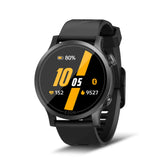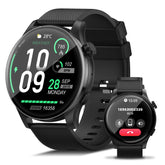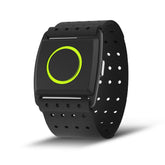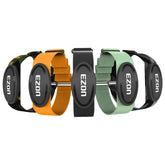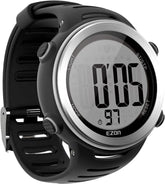Stress Tracking in Modern Fitness: What You Need to Know
In the fast-paced world of modern fitness, where high-intensity workouts and ambitious goals dominate, managing stress has become as crucial as the workouts themselves. Chronic stress disrupts recovery, impairs performance, and threatens overall well-being. Enter stress tracking watch technology, which empowers you to monitor stress levels in real time and tailor your routine for optimal health. In this guide, we’ll explore how stress tracking works, why it matters for fitness, and how to use it to enhance your physical and mental resilience.
The Impact of Stress on Fitness and Well-Being
Stress isn’t just a mental state—it’s a physiological response that floods your body with cortisol, the “stress hormone.” While short-term stress can boost focus during workouts, chronic stress leads to:
- Reduced Recovery: Cortisol breaks down muscle protein and suppresses growth hormone, delaying muscle repair.
- Impaired Immunity: Weakened immune function increases the risk of illness, forcing you to skip workouts.
- Mental Fatigue: Difficulty concentrating on form or goals, leading to subpar performance.
A stress tracking watch acts as a early warning system, helping you recognize stress patterns and adjust before they derail your progress.
How Stress Tracking Works: The Science of Heart Rate Variability (HRV)
The key to stress tracking lies in heart rate variability (HRV), the subtle changes in time between heartbeats. A higher HRV indicates a more adaptable nervous system, capable of handling stress effectively. Here’s how it translates to actionable insights:
1. HRV Analysis
- Low HRV: Signals a stressed state (sympathetic nervous system dominance), often after intense workouts or poor sleep.
- High HRV: Indicates a relaxed state (parasympathetic nervous system dominance), ideal for recovery and performance.
2. Cortisol Correlation
While direct cortisol tracking requires blood tests, HRV serves as a reliable proxy. Many sports wearable technology devices use HRV data to estimate stress levels, providing a score (e.g., 1–100) that reflects your body’s stress load.
The Role of Stress Tracking Watches in Modern Fitness
Gone are the days of guessing when to rest. Today’s stress tracking watch combines advanced sensors and algorithms to deliver personalized stress management:
1. Real-Time Stress Alerts
- Receive vibrations when stress levels spike (e.g., during a tough workout or busy day), prompting you to pause and breathe.
- EZON’s heart rate series watches use ECG-grade sensors to detect rapid HRV changes, ensuring accuracy during both rest and activity.
2. Recovery Guidance
- Based on HRV and sleep data, your watch may recommend:
- High-Stress Days: Light yoga or walking instead of a planned HIIT session.
- Low-Stress Days: Pushing for a PR, as your body is primed for intensity.
3. Holistic Well-Being Metrics
- Sync with apps to track how stress impacts sleep quality, resting heart rate, and even menstrual cycles (for women), creating a 360° view of your health.
Strategies to Manage Stress for Better Fitness Outcomes
1. Leverage Stress Tracking Data
- Morning Routine: Check your stress score upon waking. A high score (70+) means your body needs recovery; a low score (50–) signals readiness for hard work.
- Post-Workout Check: Use HRV to ensure you’re not overtraining—if stress remains elevated 30 minutes after finishing, add an extra rest day.
2. Incorporate Stress-Reduction Techniques
- Breathing Exercises: Many watches offer guided breathing sessions (e.g., 4-7-8 technique) to activate the parasympathetic nervous system.
- Mindfulness Practices: Pair your stress tracking watch with 10 minutes of meditation daily to train your body to respond to stress more calmly.
3. Adjust Training Intensity
- Stressful Periods: Prioritize low-intensity activities like swimming or cycling to maintain fitness without adding cortisol load.
- Balanced Weeks: Schedule “de-load weeks” every 4–6 weeks, reducing mileage/weight by 30% to let your body catch up on recovery.
Choosing the Right Stress Tracking Tool
Not all wearables are created equal. Look for these features in a stress tracking watch:
1. Accurate HRV Sensors
- Multi-wavelength optical sensors (red/infrared) for precise HRV measurement, even during movement.
- Chest strap compatibility for athletes who need clinical-grade accuracy during intense workouts.
2. User-Friendly Insights
- Clear stress score displays and recovery recommendations, no complex data analysis required.
- Historical trend reports to identify stress triggers (e.g., late-night screen time, inconsistent sleep).
3. Durability and Design
- Water resistance (5ATM+) and long battery life (7+ days) to track stress during workouts and daily life.
- Comfortable wear for 24/7 monitoring, with adjustable straps for any activity.
EZON’s Stress Tracking Solution: Elevate Your Resilience
EZON’s heart rate series combines medical-grade HRV tracking with intuitive design, making stress management seamless:
- Stress Score Technology: Instantly see if you’re in a state of stress or recovery, guiding workout intensity in real time.
- Sleep and HRV Integration: Understand how poor sleep spikes stress levels and adjust bedtime routines accordingly.
- Sports Mode Compatibility: Track stress during runs, rides, or hikes, ensuring you stay within a sustainable effort zone.
Prioritize Stress Management for Long-Term Success
In modern fitness, success is about more than lifting heavier or running faster—it’s about honoring your body’s needs. A stress tracking watch turns stress from a silent saboteur into a manageable metric, allowing you to train smarter, recover better, and thrive in all areas of life.
Start by acknowledging stress as part of your journey, not an obstacle. With the right tools and strategies, you’ll build resilience that enhances both your fitness performance and well-being.
